HEI SAI OR SPIRIT OF ENERGY
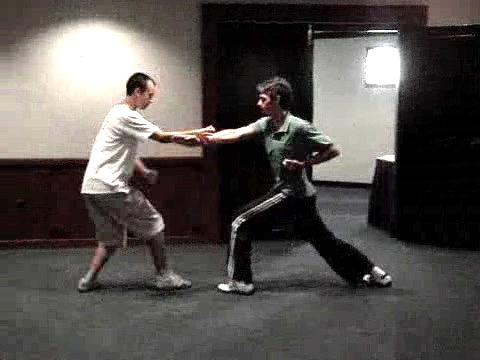
Eugene and Steve radiate the spirit of energy in their sparring
What makes a master's performance stand out from that of ordinary practitioners? There are many factors, and an important one is known in Chinese as “hei sai” (or “qi shi” in Mandarin pronunciation), which may be roughly translated as “spirit of energy”.
Chinese is very different from English. It is not feasible to translate literally. Word by word "hei" ("qi" in Mandarin) can mean "energy", and "sai" ("shi" in Mandarin) can mean "patterns".
A master and a student may perform the same forms, but the energy issuing from their performance is visibly different. Not only a master's forms are flowing and graceful, but they also radiate an invisible but perceptible force. This is “hei sai” or “spirit of energy”, or literally "energy of patterns".
How Patterns should Not be Performed
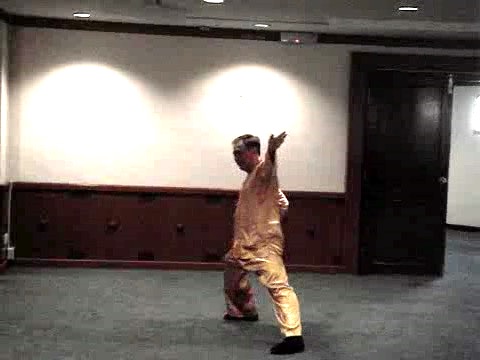
Is Grandmaster Wong linking combat sequences into a set like what the course participants do? No, he is performing some patterns as an example of how they should not be performed. Do you know what mistakes or weaknesses there are in Grandmaster Wong's performance in this video clip?
How a Sequence should be Performed
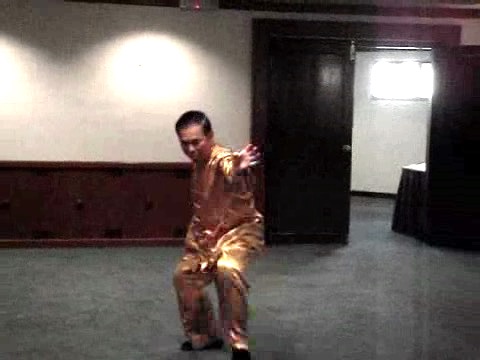
Grandmaster Wong now demonstrates how a sequence should be performed. He explains that one should be solid and agile at the same time as he sinks into a poise pattern. Notice the difference between the performance here and that in the previous video clip.
Time for a Good Laugh
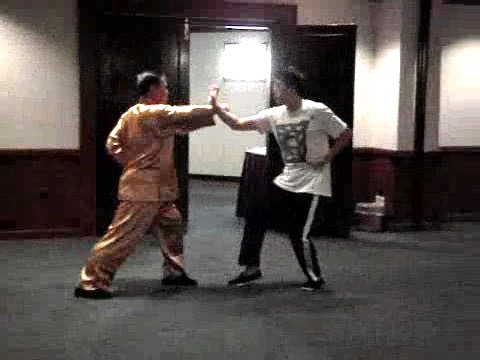
Grandmaster Wong shows how one should not execute a combat sequence. This is what we call “opium smoking”, not Shaolin Kungfu. Lessons in our school are full of fun and laughter.
Form and Spirit
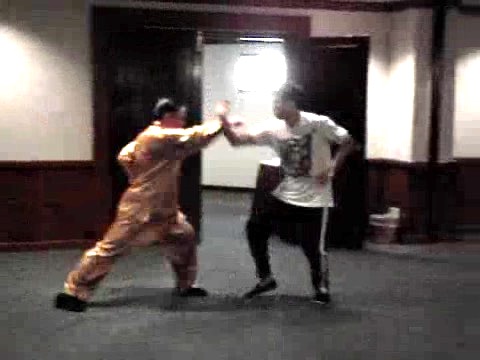
This is how Shaolin Kungfu should be performed. In Chinese (Cantonese) terms, there is “yow ying yow sai”, which means there is form as well as spirit in the performance. The patterns in this and the previous video clip are the same, but the performance is clearly different. Can you tell the different aspects?
Empty Form Without Combat Utility
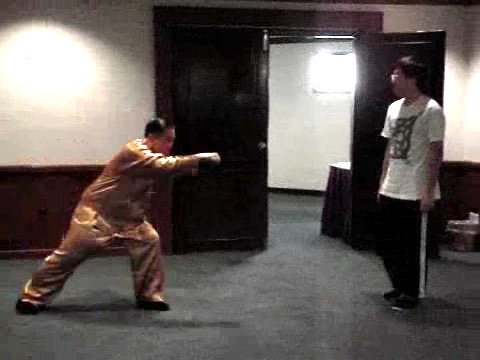
Grandmaster Wong highlights the difference. There is force and flow in good Shaolin Kungfu, whereas in “opium smoking” there is form but no spirit. And the form lacks force and flow. It is referred to as “yow zi sai mou shet chai” in Chinese, which means the forms are empty without combat utility.
Forceful and Fluid
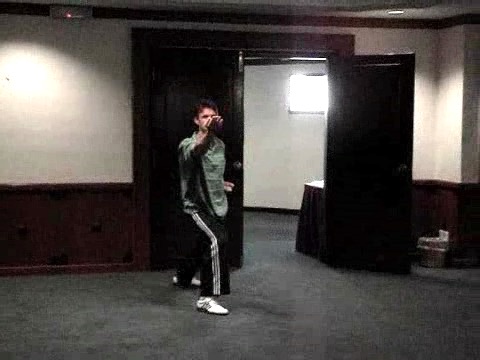
Participants at the course are fast learners. Steve performs his sequence with “form and spirit”, or “yow ying yow sai” in Chinese, like what Grandmaster Wong has just explained. The internal force is visible, and Steve's movements are fluid.
Spirit of Chi

In the past a kungfu master could have a good idea of his opponent's attainment by merely observing his movements. Even before the actual combat, he would know his chances of beating his opponent. One tell-tale sign is “hei sai”, or “spirit of chi”. Notice the “spirit of chi” as revealed in the forceful and fluid movements of both Steve and Eugene in this sparring.
Hei Sai or the Spirit of Energy of Shaolin Kungfu from Wong Kiew Kit on Vimeo.
LINKS
How to Think and Act as a Master
- Returning to the Basics
- Form, Force, Flow and Element of Threat
- Reviewing the Basic Combat Sequences
- Devising Strategies Using Combat Sequences
- Applying Strategies for Effective Combat
- Free Sparring with Prescribed Conditions
- Combat Sequences to Train Spontaneous Attacks and Responses
- Using Strategies and Tactics in Attack and Defence
- It is Heartening to see so Many People Using Kungfu in Free Sparring
- Felling and Gripping Techniques in Shaolin Kungfu
- How Sequence Training and Chi Flow Enhance Combat Efficiency
- The Tiger-Crane Set — Manifesting the Hard and the Soft in Shaolin Kungfu
- The Dragon-Tiger Set — Crystallization of Two Wahnam Traditions
- The Dragon-Form Set — Demonstrating that Softness Can be Very Powerful
- Shaolin Monkey Set — Symbolizing Spiritual Path from Cheekiness to Enlightenment
- Shaolin Five-Animal Set — Gist of Shaolin Forms and Essence
- Shaolin Pakua Set Set — An Exclusive Set Fit for Kings and Generals
- Combat Application pf Pakua — Sharing Secrets for Combat Efficiency
- Beginning to Learn some Monkey Tricks
- Refining Techniques in Combat
- Some Examples of High level Combat
- Collective Effort for Greater Benefits
- Can Sophisticated Kungfu Techniques be Used in Combat?
- Skills are usually More Important than Techniques
- One-Finger Shooting Zen — the Treasure of Shaolin Wahnam
- Raising Levels of Techniques and Tactics in Combat
- Bringing Combat Skills to More Sophisticated Levels
- Monkey Techniques are Flowing and Agile but can be Very Devastating
- Flowing with the Opponent's Momentum
- Beware of the Monkey Tricks
- Marvelous Techniques Beget Marvelous Techniques
- How to Raise your Level of Combat
- How you can Defeat your Opponents
- Employing Sophisticated Kungfu Techniques to Enhance Combat Efficiency
- Systematic Training is Essential for Combat Efficiency
- Raising Combat Efficiency from Basic to Advanced Levels
- Kungfu Philosophy and Swaying Willows
- Hands Pave the Way, Kicks to Clinch Victory
- Six Harmonies of the Double Tiger Claws
- The Amazement and Effectiveness of Monkey Kicks
- A Bag Full of Monkey Tricks
- Gentle and Flowing, yet Very Powerful
- Can your Responses still be Correct and Spontaneous in Real Fights?
- Incorporating Kicks into Combat Sequences
- Elaborate Patterns to Meet Complex Combat Situations
- The Benefits of Understanding and Applying Kungfu Philosophy
- Our Kungfu is a Training of Energy and Mind
- Ensuring Own Safety when Felling Opponents
- The Beauty and Profundity of Shaolin Felling Techniques
- Felling Techniques of the Dragon and the Monkey
- Felling an Opponent Without him Realizing What has Happened
- Pattern Analysis of the Tiger-Crane Set
- Tiger Patterns for Chin-Na, Against Kicks and Countering the Shoot
- Pattern Analysis of the Dragon-Tiger Set
- Revealing the Secret Tactic of Leak Hand
- From the Level of Techniques to the Levels of Tactics and Strategies
- Pattern Analysis of the Dragon-Form Set
- Effective Techniques for Fighting on the Ground
- Pattern Analysis of the Monkey Set
- Soft Techniques and Internal Force in Monkey Kungfu
- Interesting Monkey Patterns that are Deadly for Combat
- Pattern Analysis of the Pakua Set
- Pattern Analysis of the Five-Animal Set
- Variety of Techniques in Shaolin Five Animals
- Investigating the Combat Applications of Some Patterns
- Similar Patterns but Different Applications
- Effective Counters against Kicks, Grips and Knee Jabs
- Secrets of Skyward Cannon Punch in Continuous Attack
- Cannon Punch Towards Sky and Fierce Tiger Crouching on Ground
- Flowing Monkey Techniques against Powerful Tiger Claws
- Sophisticated Grips and Sophisticated Counters
- Breaking an Opponent's Elbow and Wrist
- Neutralizing Wrist Lock and the Three Harmonies
- Advanced Chin-Na Techniques and Counters
- Two Stories about Kicks
- How to Respond to Attacks Spontaneously and Correctly
- Can Beautiful Patterns and Flowing Movements be Effective in Combat?
- Linking Combat Sequences into a Set
- From Pre-Arranged Sparring to Combat Efficiency
- Crystalization of Combat Techniques from Past Masters
- Hei Sai or the Spirit of Energy
- Manifesting the Energy and Spirit of your Form
- Manifesting the Spirit of the Form
- Kungfu Practice is not just Physical Training but also Spiritual Cultivation
- Fluidity of Form, Energy and Spirit
- Shaolin Kungfu is Chi Kung and Meditation
- Revealing the Secrets of Shaolin Masters
- The Profundity of Shaolin Combat Application
- It is Easy to Fight against Boxers
- Avoiding a Boxer's Strong Points and Attacking his Weaknesses
- Some Effective Tactics against Boxers
- The Strategy of Not Allowing an Opponent to Escape
- The Strategy of Letting Trick Manifesting Trick
- The Strategies of Interception and of Striking Form
- Standardized Routines of Kick-Boxing Attacks
- Some Effective Counters to Kick-Boxing Attacks
- Felling a Kick-Boxer when he Kicks
- The Secrets of Two Tigers Subdue Dragon
- Shaolin Counters against Kick-Boxing and Karate
- Some Important Combat Philosophy and Principles
- It is Relatively Easy to Handle Karate Attacks
- Good Spacing When Executing Kicks
- A Variety of Taekwondo Kicks
- Effective Shaolin Counters against Taekwondo Kicks
- Trapping Legs and Subduing Opponents
- Making Expedient Changes to Surprised Attacks
- The Legacy of Sigung Ho Fatt Nam — Planting Willow in Front of Camp
- Having Fun in Throws and their Counters
- Sharing the Secret of Move Stance Change Step
- Some Unorthodox Felling Techniques Not Commonly Seen
- Felling Opponents with your Stances!
- Beware of Monkeys; they are Expert at Plucking Peaches
- Sophisticated Footwork and Leg Techniques of Monkeys and Gorillas
- Wrestling Throws are Found in Shaolin Kungfu Too
- Real Fighting is Different from Martial Sports
- Who Says there is no Ground-Fighting in Shaolin Kungfu
- An Incredible Secret of One-Finger Zen
- Understanding Muay Thai Fighting Strategies and Techniques
- Various Strategies to Counter Muay Thai Fighters
- Responding to Muay Thai Attacks Spontaneously and Correctly
- Avoiding Opponent's Strength and Attacking his Weakness
- Effective Ways to Counter Sweeping Kicks
- Effective Counters against Knee and Elbow Strikes
- Crouching Tiger against Grab Neck Elbow Strike
- Shaolin Kungfu for Combat Efficiency, Good Health and Spiritual Development
